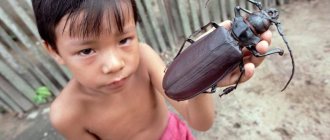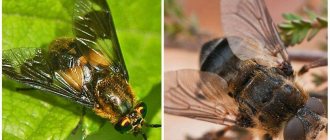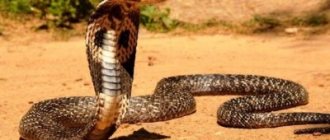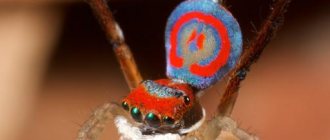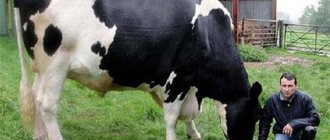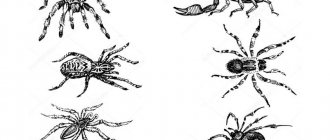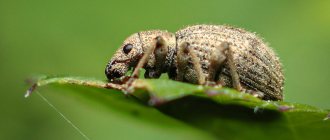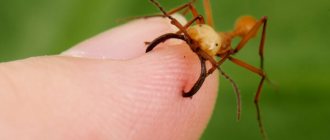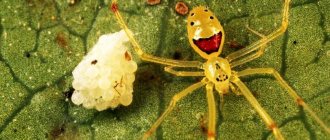Diversity of the insect world
Insects are among the most highly organized arthropods. These inhabitants of our planet with one of the most advanced nervous systems and highly developed sense organs have mastered absolutely all habitats. They have even colonized the Arctic, and the black bell mosquito is endemic to the Antarctic.
Bell mosquito
Despite all this incredible diversity, one of the first associations any person has with insects is disgusting. Behind disgust and hostility, according to psychologists, there is always the idea of danger and threat.
The most disgusting insects from the immediate environment of people are considered to be the gray blowfly, the red cockroach and the louse. Although there is clearly a lot of subjectiveness in this assessment.
Hawkmoth resembling a hummingbird
You can look at this living creature for a long time, but still not understand whether it is a hummingbird or an unusual insect. In fact, the second is true - this is the hawk moth Hemaris thysbe or the glass hummingbird, whose wingspan is 38-50 mm. When feeding with nectar, the insect incredibly looks like a tiny bird, and many people think so when they see it. The similarity in size, diurnal lifestyle, and behavior cause great confusion during the identification of these insects in the natural environment. The butterfly feeds through a long proboscis, which the rest of the time is coiled under its head. These unusual insects live in North America, and the best time to observe them is in the spring.
Ixodid tick
For residents of Russia, the ixodid tick is a real danger from which absolutely no one is safe.
An encounter with this most terrible insect of our latitudes can occur not only in the forest, but also near the house while walking with the dog. The ixodid tick is a carrier of many diseases.
Ixodid tick
The most dangerous is the focal form of tick-borne encephalitis, when the causative agent of the disease penetrates the brain and spinal cord. Death in this case occurs in 30 out of 100 cases.
Medvedka
A strange insect that looks like a cross between a beetle and a cricket. The body length of the mole cricket is 5-8 cm. The color is dark brown. The abdomen is 3 times larger than the cephalothorax. At the end of the abdomen there are paired thread-like appendages.
The chest is protected by a hard shell. The mole cricket can hide its head under it. The insect is armed with two powerful front paws, with which it digs passages in the ground. The mole cricket spends its entire life underground. The mole cricket is safe for humans, but you don’t want to touch it with your hands again.
Common flycatcher
Appearances, as we know, are deceiving. A disgusting and ugly-looking insect with a huge number of thin, quivering legs, the common flycatcher is not just a harmless creature, but even useful.
flycatcher
The fact is that its diet includes flies, cockroaches, spiders and some other small pests. However, the fact of ridding a human home of many pests does not make the centipede a welcome guest in the house. If a flytrap is discovered, most often in the bathroom, since the insect loves moisture, its disgusting appearance leaves it no chance of mercy.
Devil's flower mantis
The largest and most distinctive species of mantis lives in the tropical regions of the east and southeast of the African continent. Belonging to the order Cockroach and being a predator, this insect looks like an opening orchid flower. This property of mimicry allows the praying mantis to hide in tropical greenery from other predators and successfully hunt various flying insects.
The size of an adult female reaches 12-14 cm, males are slightly smaller - about 10 cm. Insects have well-developed wings, with a span of about 15 cm. The “Devil's Flower” has a thin, elongated body with highly developed forelimbs. With these paws, equipped with sharp spines, the praying mantis firmly holds its prey - wasps, bees, flies, butterflies and even bumblebees.
Giant stick insect
The giant stick insect holds the title of the largest insect and the most terrible beetle on the planet. The length of its body can reach 36 cm, but despite its truly gigantic size, the stick insect is a harmless and even peaceful creature. In addition, he likes to disguise himself as an ordinary branch, dry bark or wood chips, so that someone does not inadvertently disturb his peace. In photographs, these unusual and strange insects are often simply impossible to see against the background of tree bark or foliage.
Giant stick insect
Stick insects have a sweet tooth. They happily eat the fragrant leaves of flowers and trees, preferring roses and oak leaves, and adore raspberries. They live a long time and, apparently, quite happily - up to one and a half years. True, only females, since males die immediately after mating.
Suriname lantern
Butterflies often inspire delight with their beauty. Compared to other representatives of its species, the Suriname lanternfly looks like an ugly duckling. Even terrible. This creature is popularly called the crocodile butterfly because of its external resemblance to alligators. Its head sometimes reaches 24 mm, which is why the light bearer, as it is otherwise called, can be confused with a lizard or a small snake. Russians are lucky: in our area it is impossible to spot a flying crocodile, but you can stumble upon a lanternfish while traveling around Latin America. By the way, you shouldn’t be afraid of its menacing appearance - the harmless insect feeds exclusively on plant sap.
Human gadfly
The human gadfly is a dangerous parasite, the larvae of which can easily penetrate human skin. A fertilized female gadfly is capable of laying eggs in flight on the body of insects that feed on blood (mosquitoes, ticks). They, in turn, bite a person, leave them on his skin, and the larva, having emerged from the egg, safely settles under the skin for further maturation, feeding on the tissues and fluids of the human body,
After about 12 weeks, a fully mature and formed larva appears on the surface of the skin and leaves the person. After pupation, an adult insect emerges from it in two to three weeks.
Gadfly
In the medical histories of many patients, there are sometimes quite strange, if not terrible, photographs that capture the moment of the appearance of a mature insect larva on the surface of the body.
Fortunately, the habitat of this remarkable creature is limited to Central and South America.
Antlion
A graceful, dragonfly-like insect. The body length is about 3.5 cm. The wingspan is 8 cm. The imago feeds on the nectar of flowers. But this beautiful insect has a terrible larva, which gave Spielberg the idea for the Sarlacc.
On a note!
The larva hides in sandy soil, where it waits for prey. In the common antlion, the larva digs a funnel into which careless ants and bugs roll. Invertebrates are no longer destined to escape from the funnel. The larva catches them with long curved mandibles.
kissing bug
The habitat of the kissing, or triatomine, bug is the American continent. Some species are found in Asia, Africa and Australia, but there they usually live far from people.
The kissing bug, which received this romantic name because it prefers to bite people in the soft tissue around the lips and eyes, has long had a reputation as one of the most dangerous insects on the planet. They are carriers of Chagas disease (trypanosomasis): an infectious bug at the time of its bite transmits the infection to a new victim. The disease was first described in 1909 by the Brazilian physician C. Y. Chagas.
kissing bug
The main symptoms of the disease: damage to the nervous system, disruption of the gastrointestinal tract, problems with the cardiovascular system. This parasitic disease is completely curable only at the initial stage.
It is fundamentally important that when this vile insect is discovered, they always try to catch it alive in order to determine in the laboratory whether it is a carrier of the infection. It is not so easy. The bug flies well and, sensing danger, can attack a person or hide.
Army soldier ants (Eciton burchellii)
Found in the Amazon riverbed. There are also families living in Asia and Africa, but these are the best known. Now it will not surprise you that, firstly, these ants are huge - with soldiers reaching one and a half centimeters in length, and secondly, they have massive, powerful machete-like mandibles the size of half the body. They are known primarily for the fact that they disassemble into cogs all living things that they come across on their way, regardless of size. They are also completely blind, which significantly worsens the overall picture. They are called army because the entire colony, ranging from a million insects, is a 100% mobile battalion. They do not build permanent anthills like their brothers, no, they make a halt just long enough for their queen to lay thousands of eggs while the soldiers disperse around the area in search of food (anything that moves in one way or another is good for food). Then the eggs hatch and the army continues on its terrifying path. Just like the word “killer,” nature takes the words “frightening” and “army” very, very seriously. The ants carefully raise their larvae and continue onward as an almost solid mass of insect death and terror, moving steadily and efficiently across the jungle floor, flaying alive and dismembering any living creature that was too stupid, slow or simply sleeping in their path. We are not talking about painful stings or ballistic acid here, no, this horror is of a much more primitive nature - when a wave of hundreds of thousands of ants covers you and tears you to pieces with huge incredibly strong jaws, being completely blind to understand the size of the victim, assessing absolutely everything in the way is a threat to the existence of the colony. There are documented accounts of horse-sized animals being attacked and consumed by these ants. Stand next to the horse and think about what it means to you. Army ants are masters of completely organic architectural designs. For the benefit of the colony, ants use their bodies to create almost any structure imaginable, clinging to each other and forming protective walls from the elements, bridges to overcome obstacles, you name it. No living creature in the world does this except them. Fortunately, they cannot yet form a catapult from their bodies and launch themselves at the victim.
If you are overly squeamish or have a weak stomach, or are worried about your psyche, perhaps it is better for you not to read further.
Japanese giant hornet
The name of the insect speaks for itself. The Japanese huge hornet reaches a length of 4 cm with a wingspan of 6 cm. It is no coincidence that the Japanese themselves call this insect the sparrow-bee.
In case of danger, hornets can attack a person, for example, if he accidentally ends up near their nest. A hornet attack is very dangerous: its sting, about 6.25 mm long, releases a highly toxic nerve venom that destroys the victim’s tissues. Bites are very painful, cause anaphylactic shock and require immediate hospitalization. Multiple bites are especially dangerous.
Japanese giant hornet
Statistics show that hornets of this species kill on average about 40 people a year in Japan - more than any other wild animal.
The most terrible among spiders
This category includes Salpuga, a giant camel spider. The inhabitant of the countries of the East, whose length is 15 cm, makes chirping sounds, and the speed of movement of the fastest spider in the world reaches 16 km per hour. The desert dweller with strong jaws can bite, but its venom is not fatal and not particularly painful.
Phrynes, which are called whip scorpions, are among the most terrible spiders in the world. Threatening-looking tropical insects come in a variety of sizes, but are not dangerous to humans.
Rhinoceros cockroach
The largest representative of the cockroach community, nicknamed the rhinoceros, lives in Australia. Its body length reaches 8 cm, and its weight is 35 g (about how much a sparrow weighs). This not at all scary giant cockroach lives in fallen leaves and prefers eucalyptus leaves for food. The rhinoceros cockroach is capable of digging holes up to 1 m deep. He spends all his time doing this activity, working mainly in the dark. Recycling dead leaves is the insect's contribution to maintaining balance in the ecosystem.
Rhinoceros cockroach
The rhinoceros cockroach is a long-liver among its relatives; in nature, individuals are found that are 10 years old.
The friendly nature and attractiveness have caused the insect to become very popular as an exotic pet in recent years.
Scolopendra
This nasty insect includes a large number of species, and all of them do not look very nice. They live in nature for about two to three years. In some tropical countries there are species of centipedes about 25 cm .
All centipedes are predators. Particularly large species can even eat a frog. Some have adapted to living next to us and now such “beauty” can be found in our apartments. For humans, the bite is unpleasant, can cause fever, but does not pose a mortal danger.
Karakurt
Karakurt (literally “black insect”) is a type of poisonous predatory spider, one of the most terrible insects in the world.
Attacks first only in case of danger. The bite acts instantly: acute burning pain quickly spreads throughout the body, shortness of breath, vomiting, a feeling of heaviness in the chest area and a number of other symptoms appear. Without timely medical care, deaths cannot be ruled out.
Karakurt
It is interesting that not all animals are sensitive to karakurt poison. Dogs, hedgehogs, bats, amphibians, and reptiles practically do not react to bites. But camels and horses, as a rule, die.
Antikarakurt serum gives good results in eliminating the consequences of a bite in both humans and animals. Intravenous administration of novocaine, calcium chloride and magnesium hydrogen sulfate also helps.
5) Scorpios
These representatives of arthropods – scorpions – pose no small danger. These arachnid creatures number more than 2,450 species in their family. But out of a huge crowd of varieties, only 25 are deadly poisonous. Among them there are large specimens of 20-21 centimeters and very small ones reaching a maximum size of 12-13 mm. Scorpions are one of the oldest creatures on the planet, and are also not inferior in toxicity to spiders and snakes. Scorpions sometimes attack people by creeping in unnoticed from the back or side. They have very developed vision and therefore in most cases do not approach the victim directly. When I attack its prey, the scorpion thrusts its sting and injects poison. Possessors of a less toxic poison may cause the following symptoms: temporary fever, chills, temperature, headaches, swelling, burning at the injection site, nausea and lethargy. But poisonous representatives cause the following symptoms: dizziness, impaired consciousness, convulsions, tachycardia, asphyxia and sudden changes in pressure. In more severe cases: blood poisoning, paralysis, epilepsy, coma and death.
Tsetse fly
The tsetse fly is the most dangerous type of killer insect, a carrier of the deadly disease “sleeping sickness,” the causative agents of which are microscopic parasites that live in the bodies of cattle. The disease leads to damage to the immune and nervous systems and, in the absence of timely assistance, leads to death.
Tsetse fly
The insect's mouthparts have formations similar to microscopic teeth, which help the fly to chew through the blood vessels of its prey. The parasite's saliva contains a special enzyme that prevents blood clotting. An insect can drink an amount of blood equal to its own weight.
The tsetse fly's habitat includes countries south of the Sahara Desert.
Interestingly, tsetse do not attack zebras. The white and black color of the animal prevents the fly from perceiving the zebra as a living creature and a potential victim.
Africanized honey bee (Apis mellifera scutellata)
Found in South and Central America and the American Southwest. Do you know how you can spot one of them? NO WAY! There is no way to visually distinguish an Africanized bee from a regular European one. You can, however, easily sense the difference by their behavior. Regular bees will give you about 9-10 seconds of being close to the hive before they consider you a threat and attack. Thus, it is quite easy to pass them without incident. And even if they chase you, after 100 meters they will decide that they have driven the enemy far enough and will return back.
Africanized bees don't do such nonsense. They will give you no more than half a second of being at too close a distance, after which they will decide that the time has come to deal with you in such a way that it will not seem enough: the entire hive rises into the air - tens, maybe hundreds of thousands of angry bees. And you will run, waving your arms, sobbing, screaming and throwing dirt on yourself for about a kilometer, until they fall behind you. A little more scary: Africanized bees owe their existence to science. Warwick Kerr bred them in Brazil in the 50s of the last century by crossing the European bee with the African one. He wanted the bee to be able to live in the jungle. He got bees that live in swarms of hundreds of millions of individuals, control territory, are insanely aggressive and kill anywhere from several tens to several thousand people every year. And yes, capable of living in the jungle. And after they left their habitats and moved north, it turned out that they could exist perfectly not only in the jungle, but also in the desert.
Malaysian killer bug
One of the most unusual phenomena in the world of insects is the Malaysian killer bug, which feeds on the insides of insects, primarily ants.
The process of obtaining and eating food looks quite original. The killer bug first pierces the abdomen of the caught animal with its proboscis, then injects poison inside, waits until the victim’s insides turn into a mushy substance and happily feasts on it all.
Malaysian killer bug
The remaining exoskeleton of the victim is also used. Using a special adhesive substance, the killer bug attaches it to its own back as a camouflage device, eventually placing up to 20 exoskeletons on itself at the same time. The life of these creepy insects is a ready-made plot for some horror film.
Riders
Adults feed on plant foods. The larva requires protein food for development. The female ichneumon injects eggs into the victim's body and injects the virus. It subjects the host body to the development of parasitic larvae that feed on its internal organs. Caterpillars, beetles, large insects, even wasps serve as a home for future offspring. Riders pose no danger to humans.
What is the danger of a bite
The wasp is a dangerous insect.
It can sting a person a large number of times, while producing a hormone that calls on its relatives for help. When bitten, a person feels a burning sensation, as if receiving a burn. Wasp venom contains toxins that affect people differently. With normal development, after a bite a person will develop a slight swelling with redness of the skin. After some time, the swelling and redness disappear.
If a person is allergic to the components of wasp venom, then the dynamics of the development of the venom in the body are different. This may include heart rhythm disturbances, dizziness, and extensive swelling around the bite site. A person may experience vomiting and loss of consciousness. The following places are dangerous for a bite:
- bite to the face, behind the ear;
- bite on the tongue and larynx.
A great contribution to the settlement and spread of insect species was made by sailors who traveled and explored new lands. From their travels they brought not only new goods, but also new and rare diseases and a variety of living creatures, including insects.
Asian hornet - has a large (up to 6 mm) sting, large and strong jaws. But the most dangerous weapon in an insect's arsenal is poison. It contains a special component - mandorotoxin, which is a strong neurotoxin. It is known that any of the neurotoxins acts on nerve cells, damaging nervous tissue. This poisonous insect, like a wasp, can sting and bite many times. Injecting a lot of poison through its large sting.
When a hornet bites, it releases an enzyme (acetylcholine), which is needed to attract relatives. If a person has an allergic reaction to the venom of a wasp, hornet, or one of the above components, the consequences can be severe. Often fatal.
Gadfly - having passed into the adult insect (imago) phase, it does not feed. It lives off the accumulated nutrients during the larval period of development. Accordingly, gadflies do not live long. The female gastric gadfly behaves very secretively. Tries to fly up to the victim unnoticed
Lay eggs inconspicuously and carefully. A horse gadfly in reverse
It flies around the herd and buzzes loudly, scaring the animals.
Female gadflies are very fertile. After hatching, the larvae of the horse botfly penetrate the skin and move along the blood vessels to the vertebra, where they penetrate the adipose tissue of the spinal cord. Stomach bug larvae penetrate the skin and travel to the esophagus. Bodfly bites are very painful. When a bite occurs, saliva and a substance that reduces blood clotting (anticoagulants) enter the wound. This is the reason for the long-term inability of blood to clot.
During the bite and after it, a strong burning sensation is felt, to which, over time, is added severe itching. Redness of the skin occurs at the site where the bite was made. Over time, extensive swelling occurs. If you don’t provide help for the first time, the wound will fester.
The blister beetle is the owner of poisonous glands that produce the substance cantharidin. When it interacts with the skin, it causes severe abscesses and pain. There is no bite as such. The poison is contained in the integument of the insect.
Historical facts are known that in the Middle Ages, concentrated blister poison was often used to kill a person.
Red forest ant - a characteristic feature of such an ant is that, in addition to the fact that these insects bite painfully, they can throw out their poison at a distance of up to 20 cm and above. The ant's muscular abdomen contains a poison gland. When the abdomen contracts, poison is released. So if you are attacked by red ants, take care of your eyes. The following toxic substances were found in the body of this small insect:
- solenopsin (when it enters human tissue it causes a chemical burn, which is similar to a thermal burn);
- formic acid (has a corrosive effect).
These poisons of different concentrations can cause different reactions in the body. Thus, the bites of forest red ants can cause redness of the bite sites, and can lead to anaphylactic shock.
Ground beetles
This is what a ground beetle looks like: the color of the insect can be black or metallic.
Ground beetles are constantly on the move, chasing pests every minute of their lives. Over the summer, each ground beetle eats more than 300 caterpillars.
And this is what a ground beetle larva looks like.
They are black, shiny, with chest legs, also very nimble, moving surprisingly quickly. Gardeners often mistake them for pests and destroy them, thereby causing great damage to their garden. They hunt at night and try to hide during the day. During the day, each larva eats three times more pests than it weighs.
SergeyAnn FORUMHOUSE Member
The ground beetle is the most useful beetle. It does not harm the plant, on the contrary, it helps.
Pied beetles
With their shape and color, pied beetles resemble a bee or an ant, which is why they are called bee beetles or ant beetles.
This predator is invaluable for ornamental and fruit gardens, as it settles in trees and preys on bark beetles, borers and other dangerous pests. Their larvae live under the bark, move along the passages made by pests, and mercilessly destroy their larvae.
